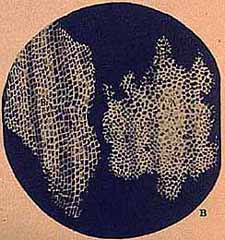


MICROGRAPHIA: OR SOME Physiological Descriptions of MINUTE BODIES MADE BY MAGNIFYING GLASSES with OBSERVATIONS and INQUIRIES thereupon. 1665.
Robert Hooke (1635-1703) could list in his not inconsiderable curriculum vitae, inventor, physicist, astronomer, biologist and architect among other talents. Sir Isaac Newton, who was mutually despised by Hooke, first wrote "If I have seen further, it is by standing on the shoulders of giants" as a sarcastic barb in a letter to Hooke, who was short in stature.
When he published Micrographia in 1665, Samuel Pepys described it as "the most ingenious book I have ever read in my life." Hooke accurately described his observations from use of a compound microscope in it and it was very popular following release.
About the flea image above he wrote:
"..a'dorned with a curiously polished suite of sable Armour, neatly jointed.."and in relation to the cork cell illustration above he observed:
"..I could exceedingly plainly perceive it to be all perforated and porous, much like a Honey-comb, but that the pores of it were not regular....these pores,....or cells,...were indeed the first microscopial pores I ever saw, and perhaps that were ever seen.."which announced the discovey of the cell. The third image is the head of a fly.
Hooke was also notable in being the official Surveyor of London following the Great Fire of 1666 and, together with Sir Christopher Wren, designed a number of replacement buildings in and around London. Curiously, no known portrait of Robert Hooke exists.



















No comments :
Post a Comment
Comments are all moderated so don't waste your time spamming: they will never show up.
If you include ANY links that aren't pertinent to the blog post or discussion they will be deleted and a rash will break out in your underwear.
Also: please play the ball and not the person.
Note: only a member of this blog may post a comment.